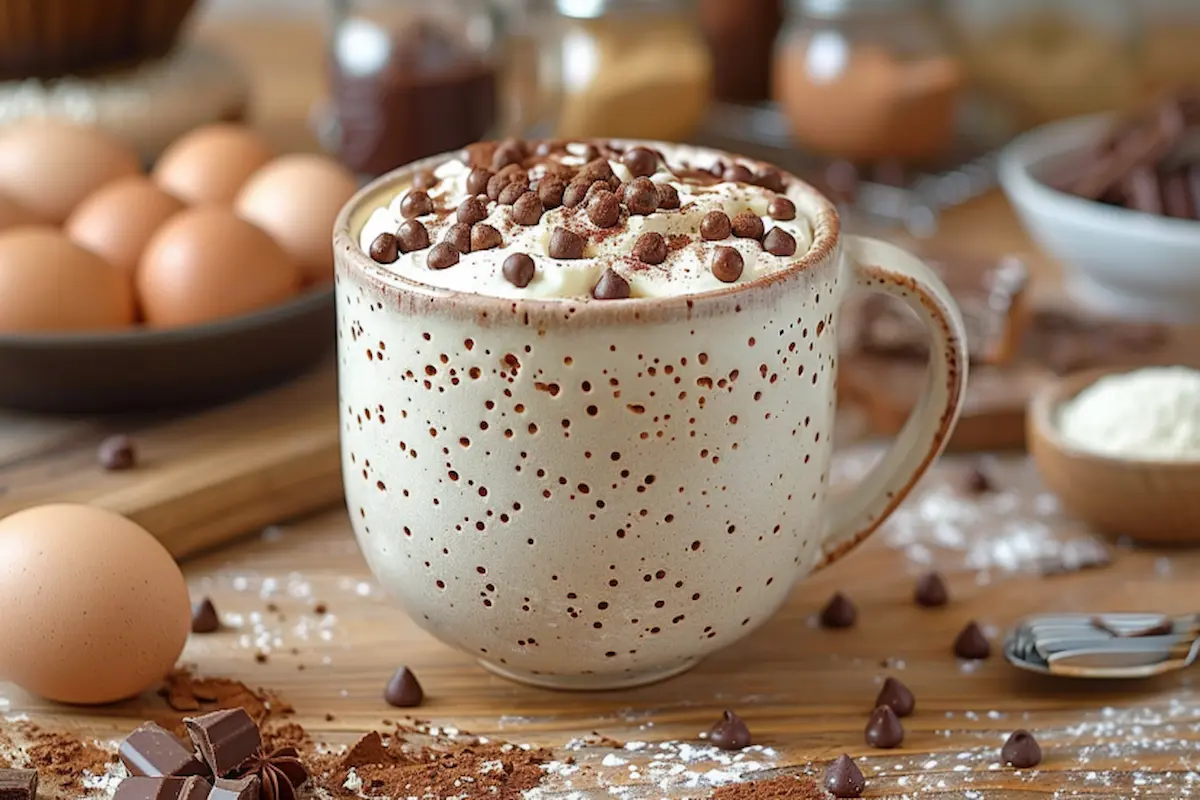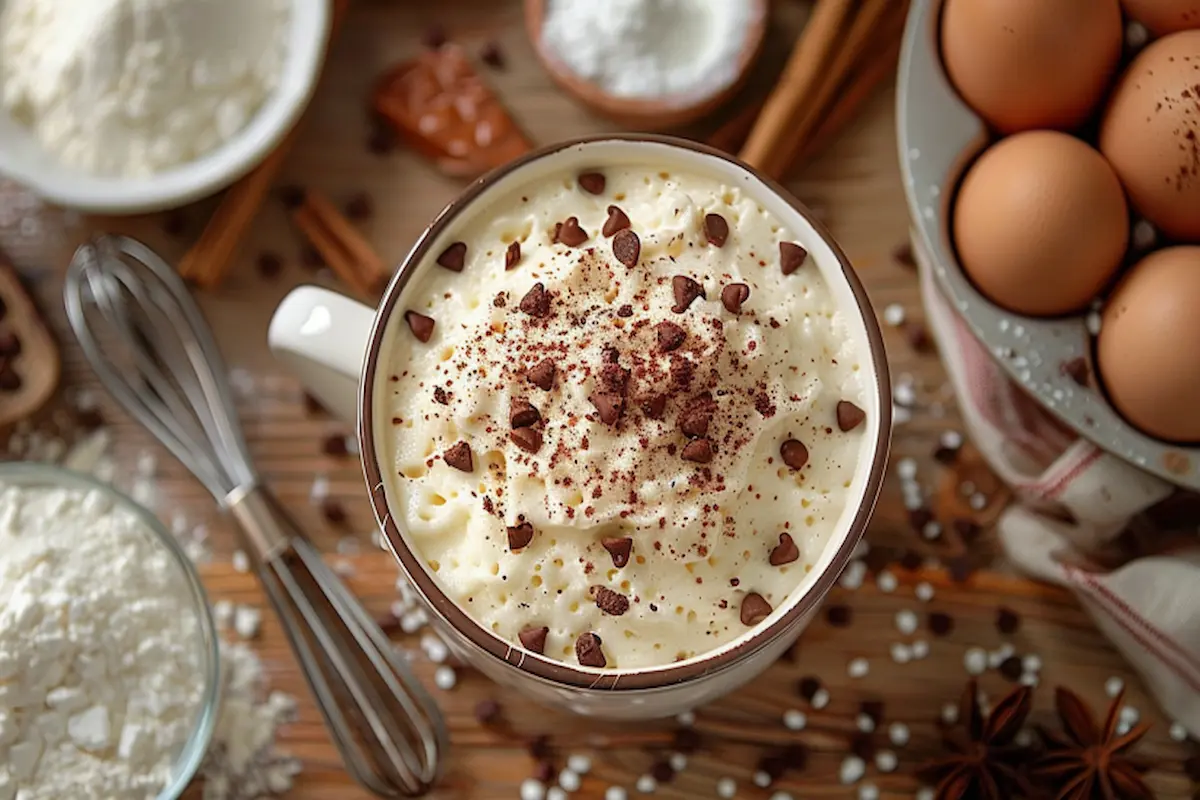Introduction: Why my mug cake never works
Have you ever eagerly whipped up a mug cake, only to be disappointed when it comes out dry, hard, or unevenly cooked? You’re not alone! Mug cakes are a popular and convenient treat, but they can sometimes be tricky to get just right. If you’ve found yourself asking, “Why does my mug cake never works?” it’s likely due to a few common mistakes. Don’t worry—this guide will walk you through the most frequent problems and provide simple solutions to help you create the perfect mug cake every time.
Mug cakes are a quick and convenient dessert, but sometimes they don’t turn out the way you’d like. If you’ve been asking, “Why does my mug cake never works?” then there could be a few reasons behind it. Let’s dive into some of the most common problems and how you can fix them.
1. Overcooking the Mug Cake
Overcooking is the most frequent issue when it comes to mug cakes. Microwaves cook much faster than ovens, which means a small cake can quickly turn rubbery or dry if left in too long. Most mug cakes should only be microwaved for about 1 to 2 minutes, depending on your microwave’s wattage.
To prevent overcooking, start with 1 minute and check the cake’s consistency. Add more time in 10-second intervals if needed. The cake should look slightly moist on top but firm underneath.
If you’re interested in baking desserts that require careful attention to cooking time, try the Perfect Earl Grey Cookies Recipe. Timing plays an important role in ensuring the right texture for both cookies and mug cakes.
2. Incorrect Ingredient Measurements
One of the easiest mistakes to make with mug cakes is not measuring the ingredients correctly. Mug cakes require precise measurements because they cook so quickly. Too much flour or not enough liquid can drastically change the outcome of the cake. Even a teaspoon too much can make the cake dense, while a little extra milk can make it gooey.
For example, if a recipe calls for 2 tablespoons of flour, make sure to level off the flour with the back of a knife. Too much flour will absorb the liquid and make the cake dry. If you find this happening often, you might enjoy a recipe that requires less precision, like the Ultimate Spicy Rigatoni Recipe, which focuses on flavor rather than exact measurements.
3. Uneven Heating in the Microwave
Microwaves are known for heating unevenly, which can be problematic when baking something as delicate as a cake in a mug. If one side of your cake is dry and the other is undercooked, it’s likely due to uneven heating. This can be remedied by pausing halfway through the cooking process and rotating the mug.
If you’re aiming for consistent results across all your dishes, whether sweet or savory, learning about heat distribution is key. For example, the Ultimate Guide to Chicken Brine discusses how even brining can affect the cooking process, and similar principles apply to mug cakes.
4. The Wrong Type of Flour
Using the wrong type of flour can make your mug cake dense or heavy. For the best results, always use all-purpose flour or cake flour, which have the right balance of gluten to give your mug cake a tender crumb. Avoid using bread flour or whole wheat flour unless specified in the recipe, as these types of flour are too heavy for a light and fluffy cake.
To better understand how different types of flour affect baking, you might want to explore the Ultimate Blackberry Cheesecake Recipe that uses cream cheese and all-purpose flour for a perfect texture.
5. Mixing the Batter Too Much
Overmixing is another common mistake. When you overmix your batter, the gluten in the flour becomes more active, which results in a tough, rubbery cake. The best approach is to stir the ingredients just until they are combined.
For a better understanding of how to mix ingredients effectively, check out the Ultimate Guide to Baking a Pineapple Upside-Down Cake. This guide explains how overmixing can ruin the texture of even the most beautiful cakes.

Why Is My Mug Cake Hard?
If your mug cake is hard rather than light and spongy, there are several potential reasons. Below are the most common culprits and how to avoid them.
6. Excessive Microwave Power
Different microwaves have different power levels, which can drastically affect how fast your mug cake cooks. If your microwave is set to a high wattage, you might end up with a hard, overcooked cake in no time.
Try reducing the microwave’s power level to 70-80%, or cook the cake for a shorter period and check it frequently. If you want more guidance on achieving the right texture and doneness in your food, explore the Ultimate Knafeh Chocolate Bar Recipe to learn how cooking times affect desserts like Knafeh, a Middle Eastern delight.
7. Too Little Fat in the Batter
Fat adds moisture to cakes, and in a mug cake, the balance between liquid and dry ingredients is crucial. If your cake turns out hard, you might not be using enough fat. Common sources of fat in mug cakes include butter, oil, and eggs.
For some great insights into balancing ingredients to keep your cake moist, take a look at the Ultimate Guide to Chicken Tortellini, which focuses on balancing creaminess and texture.
8. Not Enough Moisture
If your cake is too dry, you probably haven’t added enough liquid to the batter. Mug cakes need moisture from milk, water, or eggs to stay soft and tender. Without enough moisture, the cake will harden as it cools.
For tips on keeping dishes moist, whether they’re savory or sweet, consider trying the Cheesy Potatoes Recipe, which offers tricks to maintain moisture in your dishes.
9. Overmixing the Batter
Another reason for hard cakes is overmixing. Stirring the batter too much activates the gluten in the flour, leading to a tougher texture. Instead, mix the ingredients just until they’re combined, and no more.
For examples of how to properly mix batters for the best results, consider reading through the Ultimate Key Lime Cake Recipe, where mixing techniques are key to achieving the perfect, fluffy consistency.
How to Perfect Your Mug Cake
Now that we’ve explored the common problems, let’s look at some tips that can help you achieve the perfect mug cake every time.
10. Add Flavorful Ingredients
If you find your mug cake bland, consider adding extras like vanilla extract, cocoa powder, or a dash of cinnamon. You can also mix in chocolate chips, nuts, or fruits for extra texture and flavor.
A great resource for creative flavor ideas is the Pickle Pie Pizza Recipe. While it’s a savory dish, it’s packed with creative ways to mix unexpected flavors for a delightful experience.
11. Be Creative with Your Add-Ins
Feel free to get creative with your mug cakes by adding toppings or mix-ins like Nutella, peanut butter, or crushed cookies. Just be mindful not to add too much, as it can weigh down the cake.
For some fantastic inspiration on experimenting with toppings and fillings, check out the Ultimate Guide to Booty Dip, where unique combinations of flavors are explored.
12. Use a Mug That Conducts Heat Evenly
Not all mugs are suitable for baking. Some mugs conduct heat better than others, and using a mug that’s too thick or uneven can lead to uneven cooking. Opt for thinner mugs that are microwave-safe and avoid using thick ceramic mugs.
Learn more about how to choose kitchenware in the Complete Guide to Baked Beans, which explains the importance of choosing the right containers for even cooking.
13. Don’t Overload the Mug
Make sure your mug isn’t too full of batter. Mug cakes rise a lot as they cook, and an overfilled mug can lead to a mess in your microwave. Aim to fill the mug no more than halfway to allow the cake room to rise.
Check out how portion control plays a crucial role in other desserts, such as the Ultimate Spicy Margarita Recipe, where the right balance of ingredients makes a world of difference.

Frequently Asked Questions (FAQs) Why my mug cake never works
1. Why is my mug cake rubbery?
A rubbery mug cake is typically the result of overcooking. Mug cakes cook quickly, often within 1-2 minutes, and even 10 seconds too long can result in a dense, rubbery texture. Another reason could be overmixing the batter, which activates the gluten in the flour, making the cake tough.
To avoid this, reduce cooking time or microwave power, and mix the ingredients only until combined. For more guidance, explore the Ultimate Guide to Rotel Dip where balancing ingredients plays a crucial role in the texture of the final product.
2. Can I use a different type of flour in a mug cake?
Yes, but it’s important to use the right type of flour. All-purpose flour works best for most mug cake recipes. Cake flour can also be used if you want a lighter, fluffier texture. Avoid using heavier flours like bread or whole wheat flour unless the recipe specifically calls for it, as they can result in a dense cake.
For more insight on flour types and their effects, check out the Guide to Cake Flour.
3. Why is my mug cake dry?
A dry mug cake usually occurs when there isn’t enough liquid in the batter or it has been overcooked. Ingredients like milk, oil, or eggs add moisture, and if these are not balanced properly, your cake can turn out dry. Be sure to measure your ingredients carefully and reduce cooking time if needed.
For more tips on balancing moisture in baked goods, try reading about the Philadelphia Cheesecake Recipe, where moisture balance is crucial for a creamy texture.
4. Can I make a vegan mug cake?
Yes, vegan mug cakes are entirely possible. You can substitute milk with plant-based alternatives like almond milk, oat milk, or soy milk. Eggs can be replaced with flax eggs (a mix of ground flaxseeds and water) or a mashed banana. Be sure to choose a recipe designed for vegan ingredients for the best results.
For inspiration, consider checking out the Delicious Vegan Apple Cake Recipe for more vegan dessert ideas.
5. Why didn’t my mug cake rise?
Mug cakes rely on leavening agents like baking powder to rise. If your cake didn’t rise, it could be because you forgot to add a leavening agent or the baking powder is no longer fresh. Always check the expiration date on your baking powder and ensure you’re using the right amount for the recipe.
Explore similar techniques for achieving rise in other baked goods by checking out the Ultimate Guide to Baking a Chocolate Pound Cake, where baking techniques are crucial for a perfect rise.
6. Can I add toppings or fillings to my mug cake?
Absolutely! Toppings like chocolate chips, nuts, and sprinkles can be added to the batter before cooking for extra texture and flavor. Just be careful not to overload the batter, as too many add-ins can affect the cake’s ability to rise properly.
For ideas on fillings and toppings, look at the Ultimate Guide to Boursin Pasta, where add-ins make a simple dish stand out.
7. What kind of mug should I use for a mug cake?
It’s best to use a microwave-safe ceramic or glass mug with a smooth interior and no metallic decorations. The mug should also be large enough to allow the cake to rise without spilling over the sides, so aim for one that’s at least 12 ounces in size.
If you’re unsure about kitchen tools, check out the Ultimate Guide to Chicken Tortellini Soup, which covers the importance of choosing the right cookware.
8. How do I prevent my mug cake from overflowing?
To prevent overflow, make sure not to fill the mug more than halfway with batter. Mug cakes rise significantly while cooking, and leaving enough space will keep the batter contained. Also, using a larger mug will give the cake more room to expand.
For more tips on managing portions and preventing overflow in other recipes, check out the Ultimate Guide to Steak Tacos.
9. Can I make a gluten-free mug cake?
Yes, gluten-free mug cakes are easy to make by using gluten-free flour. Make sure to choose a blend that is designed for baking to get the right texture. You can also experiment with almond flour or coconut flour, but remember that these absorb more moisture, so you may need to adjust the liquid content.
Explore gluten-free baking with the Ultimate Guide to Gluten-Free Desserts, which provides tips for adapting your favorite recipes.
10. Why is my mug cake sticking to the mug?
If your mug cake is sticking, it may be because the mug wasn’t greased properly before adding the batter. Always lightly grease the inside of the mug with butter, oil, or non-stick spray to ensure easy release.
For more tips on preventing sticking, take a look at the Ultimate Guide to Baking Sweet Potato Bread, where similar principles apply.
11. Can I store leftover mug cake?
Mug cakes are best enjoyed immediately, but if you have leftovers, you can store them in an airtight container at room temperature for up to a day. You can also cover the mug and refrigerate the cake for up to 2 days, although the texture may become denser after cooling.
To discover more about storing baked goods, take a look at the Ultimate Guide to Cheesecake Storage.
12. Can I make a mug cake without a microwave?
Yes, if you don’t have a microwave, you can bake a mug cake in the oven. Preheat your oven to 350°F (175°C), pour the batter into an oven-safe ramekin or small dish, and bake for about 12-15 minutes or until the cake is firm.
For more oven-baked inspiration, explore the Strawberry Earthquake Cake Recipe, a great alternative for those who prefer traditional baking methods.
Conclusion: Why my mug cake never works
Mastering the perfect mug cake may seem elusive, but with a few adjustments, you can turn this quick treat into a delightful dessert every time. Whether it’s adjusting your cooking time, fine-tuning your ingredients, or understanding how your microwave works, small changes can make a big difference. By avoiding common mistakes like overmixing, using the wrong flour, or not measuring carefully, you’ll be able to enjoy a soft, fluffy, and perfectly cooked mug cake. So next time you find yourself wondering why your mug cake never works, refer back to these tips and watch your results improve!
Whether your mug cake turns out too dry, dense, or unevenly cooked, the solutions are simple and easy to implement. By following these expert tips, you’ll no longer be left asking, “Why does my mug cake never works?”—you’ll be enjoying soft, fluffy, and delicious mug cakes every time.
If you’re looking for more inspiration, check out the vast range of recipes available on OllieRecipes. You’ll find everything from sweet treats like cheesecakes to savory dishes like rotisserie chicken, all designed to help you perfect your cooking skills.

